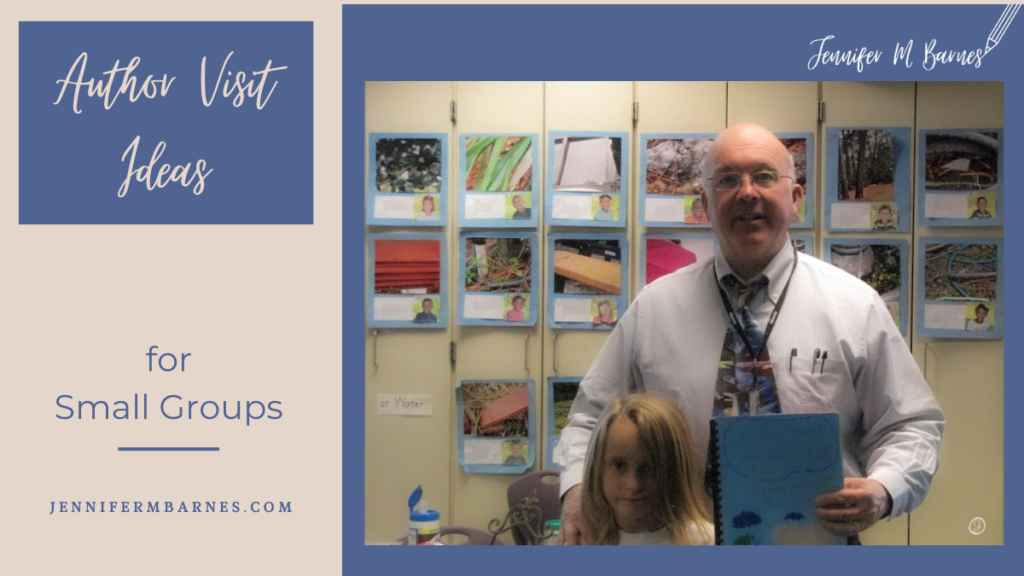Remember The Best Christmas Pageant Ever? Author Barbara Robinson penned the antics of the Herdman kids hearing the Christmas story for the first time. One of my favorite memories was watching twenty-two first-graders squeeze closer to her for a photo.
As the kids bumped, she laughed. “Wouldn’t this be a great idea for a book?”
At that moment, my students caught a glimpse of one way writers come up with ideas.
Since my South Carolina elementary school valued author visits, I learned from many during my twenty-two years there. My students gained authors’ knowledge in schoolwide assemblies and through close-up visits. Besides shuffling for photos, here are other author visit ideas you might incorporate for individual classroom visits.
Think Outside the Box
Beginning in kindergarten, students draft, critique, and edit stories. They will connect with you writer-to-writer. During these moments, you instill positive habits to last a lifetime. Prepare something memorable, and yes, something short. Your desire is to elevate their writing. Quickly.

Read
Read from your book, capitalizing on catchy lines. Engaging phrases will lodge in students’ minds as they chant with you.
Share The Story Behind the Story
- Give background information on your characters. Who inspired them? Arthur’s creator, Marc Brown, based characters on teachers, principals, classmates, and family.
- Share the setting—a real or imaginary world. Show maps.
- Highlight plots. Did ideas come from a photo like Barbara’s? Family memories? Overheard in restaurants?

Bring Engaging Materials and Tools
Authors, bring your writer’s notebook and rough drafts with visible editing. The messier, the better! Illustrators, bring large paper and artist supplies to demonstrate.
Show Them Stuff
- Do you have unbelievable photos, memes, or videos? Something as simple as a blue-footed booby bird surprises young scientists. Jerry Pallotta’s The Bird Alphabet Book inspired kids to chant his writing. “A is for Atlantic puffin. B is for blue-footed booby bird…” Consider how a video showing the bird’s unusual movements could deepen their understanding.
- Showcase some of your first draft, then highlight the changes. Talk about thought-provoking decisions you made while editing. Illustrators: share your projected cover. Let them hear your thoughts about how you changed the cover. Then, reveal the final product. This lesson is instrumental in their growth mindset about writing and drawing. When children realize we all make mistakes or don’t do something “right” the first time, they learn valuable lessons for life. They see that authors and illustrators—tall and small—continually grow, edit, and perfect their craft.
- When Jerry rolled the press sheet of The Sea Mammal Alphabet Book across my first grade classroom floor, children gasped. Jerry used that awestruck moment to reiterate that writing takes time—much more than one draft during Writing Workshop.
When children visualize progression from “sloppy copies” to press sheets, they glimpse your journey—and ideally, theirs.
Let Them Show You How Your Books Have Changed Their Writing
Over the years, Jerry visited our school several times. My students adored showing him how his mentor texts changed their alphabet books, nonfiction, and Who Would Win comparisons of animals. One child based her Author Expert Project on him, creating an animal book that mimicked his writing style. Perhaps you can get permission to share their pieces through your website. (Note: When taking photographs with children, I always kept signed permission slips up-to-date.)

Host Writing Workshop
YOU are their mentor text. Talk with them writer-to-writer. Your book talks inspire them as they try to write their own. Perhaps you could create several minilessons to offer during Writing Workshop.
- Daily Habits Before Writing
- What Writing Areas Look Like
- How I Write from Different Perspectives
Minilessons usually take 5-8 minutes. Share your topic. Then invite them to write independently. (We usually wrote 30 minutes before returning to the circle for closure.)
Welcome Them to Your Club
Extend their learning by showing secrets hidden in your books. Jerry’s books have a plethora of interactive experiences.
- The Skull Alphabet Book – Discover presidential heads hidden throughout.
- The Beetle Alphabet Book – Find Beatle’s song lyrics etched into insect bodies.
- Who Will Be My Teacher This Year? – Search for guinea pigs on each page.
Marc Brown actually hid his children’s names and meaningful dates in his illustrations.
If you don’t have secrets, create kid pages of engaging supplemental material. Show your website; demonstrate which tabs reveal secret info.
Leave Time for Q&A
Students’ questions may surprise you. (Note: Be mindful of the teachers. They know students well. They also know whose questions might inspire others and whose questions might not make sense.)
Typical Kid Questions
Getting to Know You Friend-To-Friend
- Favorite color? Food? Song? Book? Pet?
- What’s your house like?
- Can you make money writing? Have you had other jobs?
Getting to Know You Writer-To-Writer
- Where do you get ideas?
- How do you stop writer’s block?
- How long did it take to publish your book?
Imagine getting this question from Anthony Fredericks’ website: Is it true your wife is really an enchanted princess?
This post first appeared on Write2Ignite’s blog, Making the Most of Your Author Visits- Part II by Jennifer Mills Barnes – Write2Ignite
To see the first part of this series, please click here.

